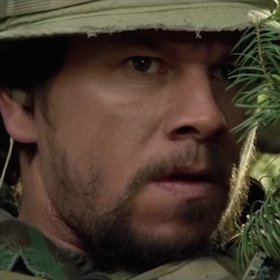'Lone Survivor' DVD Review: An Unflinching Look At The Realities Of War

5/5
There is a sad, cold chill that travels slowly from the shoulders and down the spine when confronted with the truth of a situation. Often, movies based on true stories are given to whimsical dramatization that ultimately dilutes the truth to make it more palatable, an entertaining experience. Lone Survivor isn’t like that. It’s brutal and unflinching and ultimately human. There isn’t some trite political or Hollywood message underneath this film, and while there are some moments that were exchanged for fiction, the overriding story remains.
Knowing what this story is before watching doesn’t make it easier. The title is obvious enough—one of these men, Marcus Luttrell (Mark Wahlberg), will be the only survivor of his team comprised of Luttrell, Michael Murphy (Taylor Kitsch), Danny Dietz (Emile Hirsch), and Matt Axelson (Ben Foster). Other members of their extended battalion—Shane Patton (Alexander Ludwig) and Erik Kristensen (Eric Bana)—are also lost during an attempted rescue. All this information is available online, as is Luttrell’s memoir, which covers this in great detail. From a storytelling perspective, this should be a nightmare. The audience knows the broad strokes of the story without having seen a leaked torrent.
Lone Survivor works on a story level because it embraces the fact that we know the ending. The film begins on a high note by actually having opening credits, something that’s passé these days apparently. Rather than a black screen we’re shown actual footage of SEALs being trained. It is, frankly, almost inhuman. At no point does it seem possible to train a person’s mind and body to be capable of withstanding the stress, but this is how it’s done. The opening credits are a How To guide for building hard men. This is immediately juxtaposed in the following thirty minutes of seeing Luttrell and his company getting along as brothers. They talk about home, their girls and families, they bust balls and they annoy each other. In other films this could come off as ham-fisted, but here, the pictures of kids and girlfriends and wives and parents are all from the real lives of these men, the moments taken from recollections and memory. To know these men will, over the course of a week, be killed is emotionally taxing. They all had lives outside of this, responsibilities and hopes and fears, and they had every intention and total belief that this would end and they would all come home.
The violence is appropriately unflinching. The wounds given to the Taliban are precise and usually fatal, the wounds to the soldiers are simply vicious—consisting of explosions, many bullet wounds, shrapnel and major falls off of cliffs (a number of stuntmen were injured). Sound editing is usually only noticeable when it’s really good or really bad. Lone Survivor won an Oscar for its sound editing, so it’s great. There are a number of muscle-clenching moments as Dietz and Axelson take wound after wound. The fall of flesh and bone on stone is off-putting for all the right reasons.
Blood spills throughout most of the runtime in dark-red flourishes that were achieved using squibs rather than CGI, which lends credence to the events captured on film. CGI blood is a shortcut that always looks fake (see: The Walking Dead) but more practical. The blood here works almost as a thematic point. It punctuates the action, adding a sudden burst of color to the muted grays and grainy yellows of the Afghani Mountains.
A scene of particular weight, though somewhat exaggerated for the film, is the company dealing with their hostages: an old man and two teens who are Taliban affiliated. The moral play goes between deciding if who they’re killing can even be considered murder — Are they kids? Are the Taliban? — and while the scene is probably too short, it’s worth noting that even in war there are rules, and gray zones that the rules don’t cover. These guys are as worried about going to prison as they are about getting killed. Foster and Hirsch are the standouts in that scene and in the film itself. Kitsch is his usual stoic self, but underplays the smoldering glances he relied on in Friday Night Lights and Savages. Mark Wahlberg was even a great deal more in control, only resorting to his usual wide-eyed high-pitched yell once at the near end of the film. They all have a natural chemistry as friends, and they all play the mission out with an intensity in their eyes and faces that seems impossible to replicate.
While this is a war story, it’s more about a microcosm within it: it’s the story of survival, and that’s the story writer/director Peter Berg is telling. The SEALs here weren’t worried about the bigger picture so neither is the screenplay.
The film ends with Luttrell finding asylum in a Pashtun village under the care of Mohammad Gulab. There is a climactic action scene against the Taliban that didn’t happen in real life, but is necessary because people like an exciting ending. The closing credits are delayed for a montage of pictures of the real life members involved in Operation Red Wings — showing the men they were, the loved ones they left behind. It’s a bookend to the opening credits: the building of hard men does not mean that death is a triviality. You can’t teach somehow how to not die. You can only teach them how to fight. There are no victors, just survivors.
RELATED ARTICLES
Get the most-revealing celebrity conversations with the uInterview podcast!





Leave a comment